Canon 9726B008, 9726B002, 9726B015 User manual
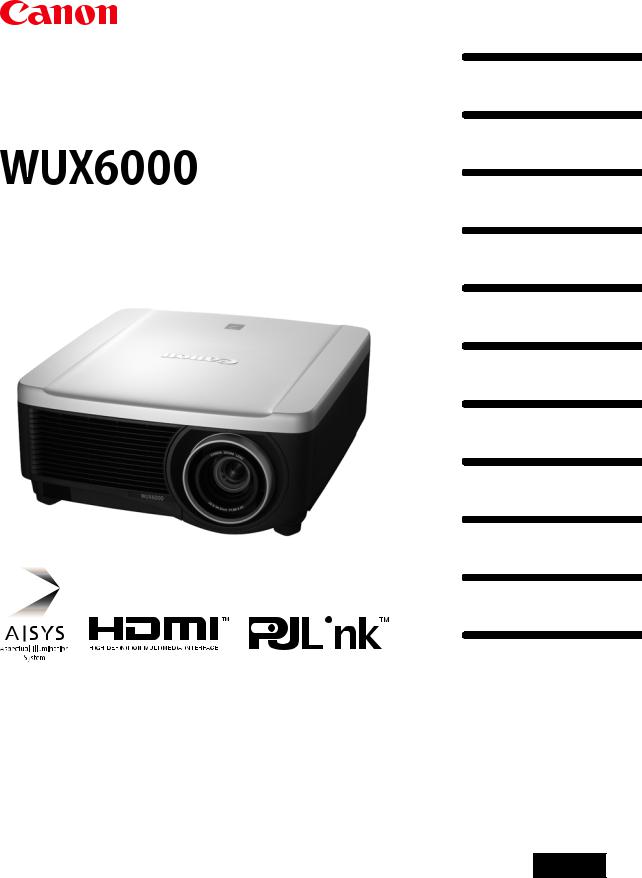
MULTIMEDIA PROJECTOR
User’s Manual
Table of Contents
Safety Instructions
Before Use
|
|
Operation |
Projecting an Image |
|
|
Useful Functions Available |
|
|
|
|
|
|
|
|
During a Presentation |
|
|
|
Setting Functions from |
|
|
|
Menus |
|
|
|
Connecting to a Network |
|
|
andInstallation |
|
|
|
|
Installation |
|
|
Maintenance |
Maintenance |
|
|
|
|
|
|
|
Other Information |
|
|
|
|
|
|
Appendix |
|
|
|
Index |
|
|
|
||
|
|
||
|
|
|
|
|
|
|
|
ENG
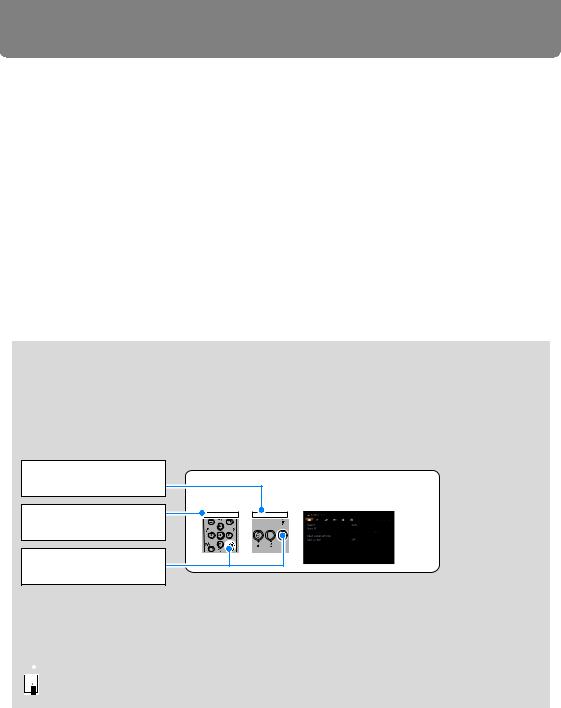
How to Use This Manual
Thank you for purchasing a Canon projector.
The WUX6000 Multimedia Projector (hereinafter referred to as “the projector”) is a high-performance projector that is capable of projecting a high-resolution computer screen and high-quality digital image on a large screen.
This Manual
This is the user’s manual for WUX6000 Multimedia Projectors. The “Operation” section describes how to use the projector. The “Installation and Maintenance” section describes the projector installation procedure, network connection procedure, and regular maintenance. Read this manual thoroughly to make the most of your projector. Installation of the projector should be performed by a qualified technician, if possible. Contact the Canon Customer Support Center for further information.
Symbols of Button Operations
The projector can be operated using the buttons on the remote control or on the side of the projector. The remote control allows you to operate all functions of the projector.
In this document, the button’s operations are shown as below.
Operation of buttons on side of projector
Remote control button operation
Indicate the buttons to be pressed
Selecting Screen Aspect
Select the correct aspect ratio for the screen which is used.
1 Press the MENU button to display the menu window.
Remote control |
Projector |
Symbols Used in This Manual
Meanings of the symbols used in this manual are as follows.
 A precaution about operation or restriction is given here.
A precaution about operation or restriction is given here.  Indicates supplemental information to note in use.
Indicates supplemental information to note in use.
2

How to Use This Manual
Copyright Notice
Please note that enlarging or reducing the size of an image for commercial purposes or public presentation may infringe on the legally protected copyright or the copyright holder of the original material.
About Trademarks
•Ethernet is a registered trademark of Xerox Corporation.
•Microsoft, Windows, Windows Vista, Windows 7, Windows 8 and Aero are registered trademarks or trademarks of Microsoft Corporation in the United States and / or other countries.
•Mac, Mac OS and Macintosh are trademarks of Apple Inc., registered in the United States and / or other countries.
•HDMI, the HDMI logo and High-Definition Multimedia Interface are trademarks or registered trademarks of HDMI Licensing, LLC.
•PJLink is a registered trademark, or an application has been submitted for trademark, in Japan, the United States and / or other countries or regions.
•AMX is a trademark of AMX Corporation.
•Crestron®, Crestron RoomView®, and Crestron Connected™ are registered trademarks of Crestron Electronics, Inc.
3

Projector Highlights
High-Resolution LCOS Projection
Projection at 1920x1200 (WUXGA), thanks to high-resolution reflective liquid crystal on silicon (LCOS) panels.
Lens Shift
Lens shift enables motorized image repositioning up, down, left, or right (P46) for greater freedom in installation.
Motorized Zoom and Focus Adjustment
Efficient setup using motorized zoom and focus adjustment.
Five Lens Units Available
Choose the optimal lens unit for the projection distance or purpose.
Split-Screen Display
Side-by-side projection of two input images from devices connected to the projector. (P67)
USB File Viewer
Project JPEG images stored on a USB flash drive. (P65)
Edge Blending
Blend the overlapping edges of images from multiple projectors to make the overall image more seamless. (P154)
Displaying Test Pattern
Project a range of test patterns, with no image input needed. (P153)
Networked Multi-Projection (NMPJ)
Project images from multiple computers via a network connection.
For details on Networked Multi-Projection (NMPJ), refer to the separate user’s manual.
4

Quick Reference Guide
This Quick Reference Guide will help you find functions that make full use of the projector and are useful for producing an attractive presentation, etc.
Connecting the Projector
Connecting to the Computer (P132 - P134) Connecting to AV Equipment (P135 - P137)
Projecting an Image
Starting Projection (P38)
Selecting an Input Signal (P39, P40)
Projecting Images from Two Sources at Once (P67)
Adjusting the Image
Adjusting the Image Size and Focus (P44, P45)
Adjusting Keystone Distortion (P54) Adjusting Aspect Ratio (P48 - P53)
Eliminating Flickers from Computer Screen and Adjusting Positional Shift (P77, P78)
Adjusting Colors and Image Quality
Projecting an Image on a Greenboard (P148)
Selecting an Image Mode Suitable for the Projecting Image (P84)
Making Fine Color Adjustments (P88) Removing Noise (P90, P91)
Changing the Remote Control
Channel (P102)
Resetting Projector Setting
Canceling the Password (P104)
Initializing the Network Setting (P170)
Restoring Default Menu Settings (P111)
Miscellaneous Functions
Using Power Management (P98)
Turning on the Projector by Connecting the Power Cord (P99)
Disabling the Beep During Operation (P100)
Disabling Buttons (P101) Hiding Guide Messages (P149) Setting a Password (P104)
Reducing the Lamp Brightness (P95) Displaying Test Pattern (P153) Selecting Audio In Terminal (P106)
Combining Images from Multiple Projectors (P154 - P161)
Projecting Images Via Network (For details on Networked Multi-Projection (NMPJ), refer to the separate user's manual.)
Producing a Presentation
Temporarily Blacking Out an Image (P62)
Freezing the Picture (P62)
Adjusting the Volume (P63) Muting the Sound (P63) Zooming an Image (P64)
Projecting Images on a USB Flash Drive (P65, P66)
5

Table of Contents |
|
How to Use This Manual............... |
2 |
Projector Highlights...................... |
4 |
Quick Reference Guide ................ |
5 |
Safety Instructions...................... |
10 |
Safety Precautions............................... |
11 |
CAUTION ON HANGING FROM THE |
|
CEILING ................................................ |
11 |
AC Power Cord Requirement.............. |
14 |
Federal Communication Commission |
|
Notice .................................................... |
15 |
Precautions for Use ............................. |
17 |
Installation and Handling |
|
Precautions .......................................... |
18 |
Precautions on the Lamp .................... |
20 |
Precautions for the Batteries of the |
|
Remote Control .................................... |
21 |
For Safe Use ................................ |
23 |
Open Source Software ............... |
25 |
Before Use.............................. |
27 |
Supplied Accessories................. |
28 |
Preparing the Remote Control... |
29 |
Part Names .................................. |
31 |
Projector ............................................... |
31 |
Remote control..................................... |
32 |
Side control .......................................... |
34 |
Input Terminal ...................................... |
36 |
Operation |
|
Projecting an Image............... |
37 |
Step 1 Turn the Projector On .... |
38 |
Step 2 Select an Input Signal.... |
39 |
Types of Input Signals......................... |
39 |
Selecting an Input Signal .................... |
40 |
Step 3 Adjust the Image ............ |
41 |
Setting the Display Resolution of the |
|
Computer .............................................. |
41 |
Auto PC Adjustment ............................ |
43 |
Focusing, Resizing, or Moving the |
|
Image..................................................... |
44 |
Step 4 Select an Aspect Ratio |
|
(Screen Aspect) Matching the |
|
Screen .......................................... |
48 |
Selecting Screen Aspect ..................... |
48 |
Moving Image with 16:9 D. Image Shift |
|
............................................................... |
50 |
Moving Image with 4:3 D. Image Shift |
|
............................................................... |
51 |
Resetting the Image Shift.................... |
52 |
Select the Aspect ................................. |
52 |
Types of Aspect Ratios ....................... |
52 |
Selecting an Aspect Ratio................... |
53 |
Step 5 Correct the Image |
|
Distortion ..................................... |
54 |
Adjusting Keystone Distortion ........... |
54 |
Step 6 Select the Image Quality |
|
(Image Mode) ............................... |
57 |
Image Modes ........................................ |
57 |
Step 7 Set Power-Saving Settings |
|
...................................................... |
59 |
Step 8 Turn the Projector Off .... |
60 |
Useful Functions Available |
|
During a Presentation ........... |
61 |
Useful Presentation Functions .. |
62 |
Temporarily Blacking Out an Image... |
62 |
Freezing the Picture............................. |
62 |
Adjusting the Volume .......................... |
63 |
Muting the Sound................................. |
63 |
Zooming Part of an Image................... |
64 |
Projecting Images on a USB Flash |
|
Drive ............................................. |
65 |
Split-Screen Display.................... |
67 |
Setting Functions from Menus |
|
................................................. |
71 |
Using Menus................................ |
72 |
Menu Configuration ............................. |
72 |
Basic Menu Operations ....................... |
73 |
Setting Display Status (Input |
|
Settings)....................................... |
75 |
Selecting the Aspect............................ |
75 |
Setup Using Auto PC........................... |
76 |
6

Selecting an Input Signal |
|
(Analog PC Input)................................. |
76 |
Adjusting the Input Signal |
|
(Total dots)............................................ |
77 |
Adjusting the Input Signal |
|
(Tracking).............................................. |
77 |
Adjusting the Input Signal |
|
(Horizontal / Vertical position) ............ |
78 |
Adjusting the Input Signal |
|
(Horizontal / Vertical pixels) ................ |
78 |
Adjusting HDMI Input Level ................ |
79 |
Setting the HDMI Color Format........... |
79 |
Specifying HDMI Overscan ................. |
80 |
Specifying Progressive Processing... |
80 |
Specifying the Slideshow Interval...... |
81 |
Specifying Split-Screen Display ......... |
82 |
Adjusting Image Quality (Image |
|
Adjustment) ................................. |
83 |
Specifying Image Priority in Split- |
|
Screen Mode......................................... |
83 |
Specifying the Image Mode................. |
84 |
Creating/Saving a User Profile ........... |
85 |
Adjusting Brightness........................... |
86 |
Adjusting Contrast............................... |
86 |
Adjusting Sharpness ........................... |
87 |
Correcting Gamma............................... |
87 |
Adjusting Colors .................................. |
88 |
Adjusting to the Ambient Light |
|
(Ambient Light) .................................... |
89 |
Reducing Image Noise |
|
(Random noise reduction) .................. |
90 |
Reducing Image Noise |
|
(MPEG noise reduction) ...................... |
90 |
Reducing Image Noise |
|
(Mosquito noise reduction)................. |
91 |
Dynamic Gamma Adjustment ............. |
91 |
Correcting Memory Color.................... |
92 |
Fine-Tuning Colors |
|
(6-axis Color Adjustment) ................... |
92 |
Fine-Tuning Gamma ............................ |
93 |
Specifying Lamp Control .................... |
94 |
Specifying the Lamp Mode ................. |
95 |
Resetting Image Adjustment Settings |
|
............................................................... |
95 |
Customizing System Operation |
|
(System Settings)........................ |
96 |
Registering User Logos ...................... |
96 |
Table of Contents |
|
Positioning User Logos....................... |
96 |
No Signal Screen ................................. |
97 |
Screen When Blank ............................. |
97 |
Selecting a Logo at Startup ................ |
98 |
Specifying Power Management Mode |
|
............................................................... |
98 |
Specifying Power Management Duration |
|
............................................................... |
99 |
Specifying Direct Power-On................ |
99 |
Specifying Silence or Operating Tones |
|
............................................................. |
100 |
Specifying Key Repeat Operation .... |
100 |
Locking Projector or Remote Buttons |
|
............................................................. |
101 |
Assigning a Channel for Remote Control |
|
............................................................. |
102 |
Reducing Motion Blur........................ |
103 |
Selecting a Display Language .......... |
103 |
Requiring a Password for Operation |
|
............................................................. |
104 |
Setting a Password............................ |
105 |
Using the Remote Control [Fn] Button |
|
............................................................. |
105 |
Selecting Audio Input ........................ |
106 |
Restoring Original Gamma Settings |
|
............................................................. |
107 |
Specifying HDMI Input....................... |
108 |
Resetting the Lamp Counter............. |
108 |
Resetting the Air Filter Counter........ |
110 |
Updating the Firmware ...................... |
110 |
Resetting to the Default Setting ....... |
111 |
Checking Projector Information |
|
.................................................... |
112 |
Installation and |
|
Maintenance |
|
Installation............................ |
113 |
Before Installation ..................... |
114 |
Precautions When Carrying/ |
|
Shipping the Projector ...................... |
114 |
Precautions for Installation............... |
114 |
Installation Procedure............... |
118 |
Setting Up the Projector.................... |
118 |
Installing / Removing the Lens Unit |
|
............................................................. |
120 |
Contents of Table
7

Table of Contents |
|
Relationship Between Image Size and |
|
Projecting Distance ........................... |
125 |
Lens Shift Function ........................... |
129 |
Connection Procedure ............. |
131 |
Connectable Equipment and Input |
|
Terminals ............................................ |
131 |
Connecting a Computer .................... |
132 |
Connecting AV Equipment................ |
135 |
Plugging the Projector In .................. |
138 |
Starting Projection.................... |
139 |
Starting and Stopping Projection..... |
139 |
Changing Notebook Computer Screen |
|
Output ................................................. |
140 |
Installation-Related Menu Settings |
|
.................................................... |
141 |
Locking Installation Settings ............ |
141 |
Flipping Image Display...................... |
141 |
Specifying the Screen Aspect .......... |
142 |
Adjusting the Size of Projected Images |
|
............................................................. |
143 |
Specifying Keystone Correction ...... |
144 |
Specifying Digital Image Shift .......... |
145 |
Specifying Micro Digital Image Shift |
|
............................................................. |
145 |
Adjusting Image Registration ........... |
146 |
Specifying the Fan Mode................... |
146 |
Specifying Vertical Projection .......... |
147 |
Saving and Restoring Lens Positions |
|
............................................................. |
147 |
Screen Color Adjustment.................. |
148 |
Specifying a Menu Position .............. |
149 |
Showing/Hiding the Guide Screen ... |
149 |
Showing/Hiding Input Status ............ |
150 |
Showing/Hiding Overheat Warnings |
|
............................................................. |
150 |
Specifying the Menu Display Time... |
151 |
Showing/Hiding Lamp Replacement |
|
Warnings............................................. |
151 |
Showing/Hiding Filter Cleaning |
|
Warnings............................................. |
152 |
Showing/Hiding Split-Screen ID ....... |
152 |
Displaying Test Patterns ................... |
153 |
Projecting from Multiple Projectors at |
|
Once (Edge Blending) ....................... |
154 |
Connecting to a Network .... |
163 |
Network Connection Overview |
|
.................................................... |
164 |
Connection Methods ......................... |
164 |
Completing Projector Settings |
|
.................................................... |
165 |
Locking/Unlocking Network Settings |
|
............................................................. |
165 |
Specifying the Network Password ... |
166 |
Registering a Network Password ..... |
167 |
Specifying Standby Power |
|
Consumption...................................... |
167 |
Specifying the Network Function ..... |
168 |
Viewing the IP Address, Gateway |
|
Address, and MAC Address.............. |
168 |
Specifying DHCP................................ |
169 |
Specifying TCP/IP Settings ............... |
169 |
Initializing Network Settings ............. |
170 |
Specifying PJLink Settings............... |
170 |
Specifying AMX Device Discovery ... |
171 |
Specifying Crestron RoomView ....... |
172 |
Completing Computer Settings |
|
.................................................... |
173 |
Specifying an IP Address.................. |
173 |
Setting Up the Network ..................... |
177 |
Control via the Web Screen .............. |
191 |
Maintenance......................... |
193 |
Cleaning the Projector and the Air |
|
Filter............................................ |
194 |
Cleaning the Air Filter........................ |
194 |
Replacing the Air Filter ............. |
196 |
Replacing the Lamp .................. |
197 |
Replacement Lamp ............................ |
198 |
Replacing the Lamp........................... |
199 |
Appendix |
|
Appendix .............................. |
201 |
Troubleshooting........................ |
202 |
LED Indicator Meanings .................... |
202 |
Symptoms and Solutions.................. |
203 |
8

Relationship between Aspect and |
|
Screen Aspect ........................... |
209 |
Displayed Test Patterns ........... |
213 |
Supported Signal Types........... |
214 |
Product Specifications ............. |
216 |
Index........................................... |
224 |
Option ........................................ |
227 |
Menu Configuration .................. |
228 |
Table of Contents
Contents of Table
9
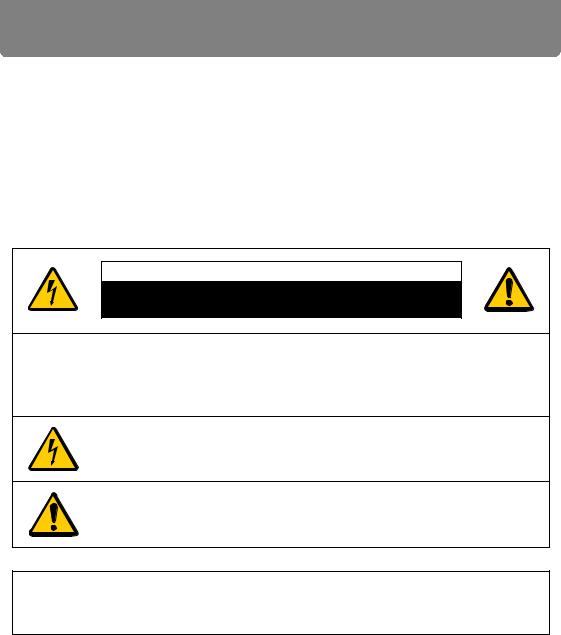
Safety Instructions
Before installing and operating the projector, read this manual thoroughly. This projector provides many convenient features and functions. Operating the
projector properly enables you to manage those features and maintain it in good condition for many years to come.
Improper operation may result in not only shortening the product life, but also malfunctions, fire hazards, or other accidents.
If your projector does not seem to be operating properly, read this manual again, check operations and cable connections, and try the solutions in the “Troubleshooting” section in the back of this manual. If the problem still persists, contact the Canon Customer Support Center.
CAUTION
RISK OF ELECTRIC SHOCK
DO NOT OPEN
CAUTION: TO REDUCE THE RISK OF ELECTRIC SHOCK, DO NOT REMOVE COVER (OR BACK). NO USER-SERVICEABLE PARTS INSIDE EXCEPT LAMP REPLACEMENT. REFER SERVICING TO QUALIFIED SERVICE PERSONNEL.
THIS SYMBOL INDICATES THAT DANGEROUS VOLTAGE CONSTITUTING A RISK OF ELECTRIC SHOCK IS PRESENT WITHIN THIS UNIT.
THIS SYMBOL INDICATES THAT THERE ARE IMPORTANT OPERATING AND MAINTENANCE INSTRUCTIONS FOR THIS UNIT IN THE OWNER’S MANUAL.
CAUTION
Not for use in a computer room as defined in the Standard for the Protection of Electronic Computer / Data Processing Equipment, ANSI / NFPA 75.
10
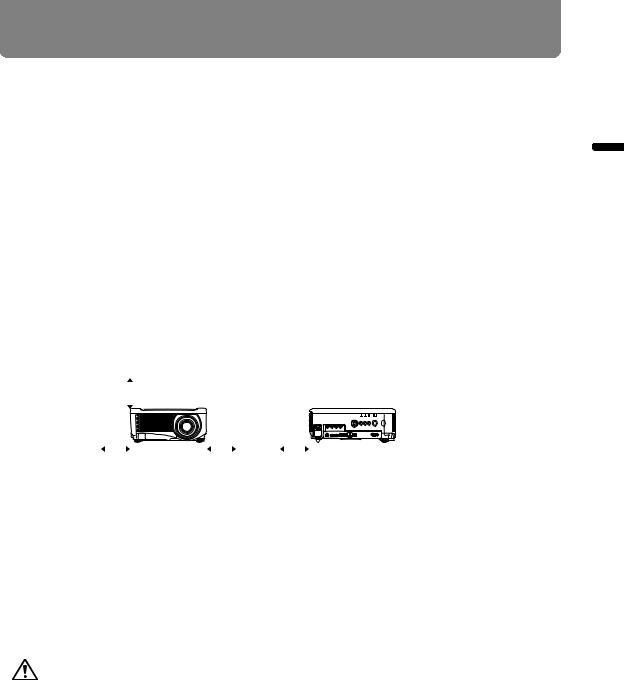
Safety Instructions
 Safety Precautions
Safety Precautions
WARNING: |
|
|
|
|||||||||||||||||||||
• THIS APPARATUS MUST BE GROUNDED. |
|
|
|
|||||||||||||||||||||
• TO REDUCE THE RISK OF FIRE OR ELECTRIC SHOCK, DO NOT EXPOSE |
|
|||||||||||||||||||||||
|
THIS APPLIANCE TO RAIN OR MOISTURE. |
Safety |
||||||||||||||||||||||
• |
This projector produces intense light from the projection lens. Do not stare |
|||||||||||||||||||||||
• |
directly into the lens, otherwise eye damage could result. Be especially careful |
Instructions |
||||||||||||||||||||||
Allowing the proper amount of space on the top, sides, and rear of the projector |
||||||||||||||||||||||||
|
that children do not stare directly into the beam. |
|
||||||||||||||||||||||
• |
Install the projector in a proper position. Otherwise it may result in a fire hazard. |
|
||||||||||||||||||||||
|
cabinet is critical for proper air circulation and cooling of the unit. The diagrams |
|
||||||||||||||||||||||
|
shown here indicates the minimum space required. If the projector is to be built |
|
||||||||||||||||||||||
|
into a compartment or similarly enclosed, these minimum distances must be |
|
||||||||||||||||||||||
|
maintained. |
|
|
|
||||||||||||||||||||
|
|
|
|
|
|
SIDE and TOP |
REAR |
|
||||||||||||||||
|
|
|
|
|
|
|
|
|
|
|
|
|
|
|
|
|
|
|
|
|
|
|
|
|
|
|
|
|
|
|
|
|
|
|
|
|
|
|
|
|
|
|
|
|
|
|
|
|
|
|
|
|
|
|
|
|
|
|
|
|
|
|
|
|
|
|
|
|
|
|
|
|
|
|
|
|
|
|
|
|
|
|
|
|
|
|
|
|
|
|
|
|
|
|
|
|
|||
|
|
|
|
|
|
|
|
50 cm (1.6') |
|
|
|
|
|
|
|
|
|
|
|
|
||||
|
|
|
|
|
|
|
|
|
|
|
|
|
|
|
|
|
|
|
|
|
|
|
|
|
|
|
|
|
|
|
|
|
|
|
|
|
|
|
|
|
|
|
|
|
|
|
|
|
|
|
|
|
|
|
|
|
|
|
|
|
|
|
|
|
|
|
|
|
|
|
|
|
|
|
|
|
|
|
|
|
|
|
|
|
|
|
|
|
|
|
|
|
|
|
|
|
|
|
|
50 cm |
50 cm |
50 cm |
(1.6') |
(1.6') |
(1.6') |
•Do not cover the ventilation slots on the projector. Heat build-up can reduce the service life of your projector, and can also be dangerous.
•If the projector is unused for an extended time, unplug the projector from the power outlet.
•Do not project the same image for a long time.
An afterimage may remain on the LCD panels due to the characteristics of the panels of the projector.
 CAUTION ON HANGING FROM THE CEILING
CAUTION ON HANGING FROM THE CEILING
When hanging the projector from the ceiling, clean the air intake vents and top of the projector periodically with a vacuum cleaner. If you leave the projector unclean for a long time, the cooling fans can be clogged with dust, and it may cause a breakdown or a disaster.
DO NOT SET THE PROJECTOR IN GREASY, WET, OR SMOKY CONDITIONS SUCH AS IN A KITCHEN TO PREVENT A BREAKDOWN OR A DISASTER. IF THE PROJECTOR COMES IN CONTACT WITH OIL OR CHEMICALS, IT MAY BECOME DETERIORATED.
11

Safety Instructions
■ READ AND KEEP THIS OWNER’S MANUAL FOR LATER
USE.
All the safety and operating instructions should be read before beginning to operate the product.
Read all of the instructions given here and retain them for later use. Unplug this projector from the AC power supply before cleaning. Do not use liquid or aerosol cleaners on the projector. Use a damp cloth for cleaning.
Follow all warnings and instructions marked on the projector.
For added protection of the projector during a lightning storm, or when it is left unattended or unused for long periods of time, unplug it from the wall outlet. This will prevent damage due to lightning and power surges.
Do not expose this unit to rain or use near water... for example, in a wet basement,
near a swimming pool, etc...
Do not use attachments not recommended by the manufacturer as they may result in hazards.
Do not place this projector on an unstable cart, stand, or table. The projector may fall, causing serious injury to a child or adult, and serious damage to the projector. Use only with a cart or stand recommended by the manufacturer, or sold with the projector. Wall or shelf mounting should be carried out in accordance with the manufacturer’s directions, and should use a mounting kit approved by the manufacturers.
An appliance and cart combination should be moved with care. Sudden stops, excessive force, and uneven surfaces may cause the appliance and cart combination to overturn.
Slots and openings in the rear and front of the cabinet are provided  for ventilation, to insure reliable operation of the equipment and to protect it from overheating.
for ventilation, to insure reliable operation of the equipment and to protect it from overheating.
The openings should never be covered with cloth or other materials, and the bottom opening should not be blocked by placing the projector on a bed, sofa, rug, or other similar surface. This projector should never be placed near or over a radiator or heat register.
This projector should not be placed in a built-in installation such as a book case unless proper ventilation is provided.
12

Safety Instructions
Never push objects of any kind into this projector through cabinet slots as they may touch dangerous voltage points or short out parts that could result in a fire or electric shock. Never spill liquid of any kind onto the projector.
Do not install the projector near the ventilation duct of air-conditioning equipment.
This projector should be operated using only the type of power source indicated on the marking label. If you are not sure of the type of power supplied, contact the Canon Customer Support Center or local power company.
Do not overload wall outlets and extension cords as this can result in fire or electric shock. Do not allow anything to rest on the power cord. Do not locate this projector where the cord may be damaged by people walking on it.
Do not attempt to service this projector yourself as opening or removing covers may expose you to dangerous voltages or other hazards. Refer all servicing to qualified service personnel.
Unplug this projector from the wall outlet and refer servicing to qualified service personnel under the following conditions:
a.When the power cord or plug is damaged or frayed.
b.If liquid has been spilled into the projector.
c.If the projector has been exposed to rain or water.
d.If the projector does not operate normally after following the operating instructions. Adjust only those controls that are covered in the operating instructions as improper adjustment of other controls may result in damage and will often require extensive work by a qualified technician to restore the projector to normal operating condition.
e.If the projector has been dropped or the cabinet has been damaged.
f.When the projector exhibits a distinct change in performance-this indicates a need for servicing.
When replacement parts are required, be sure the service technician uses replacement parts specified by the manufacturer that have the same characteristics as the original parts. Unauthorized substitutions may result in fire, electric shock, or injury.
Upon completion of any service or repairs to this projector, ask the service technician to perform routine safety checks to determine that the projector is in safe operating condition.
Instructions Safety
13
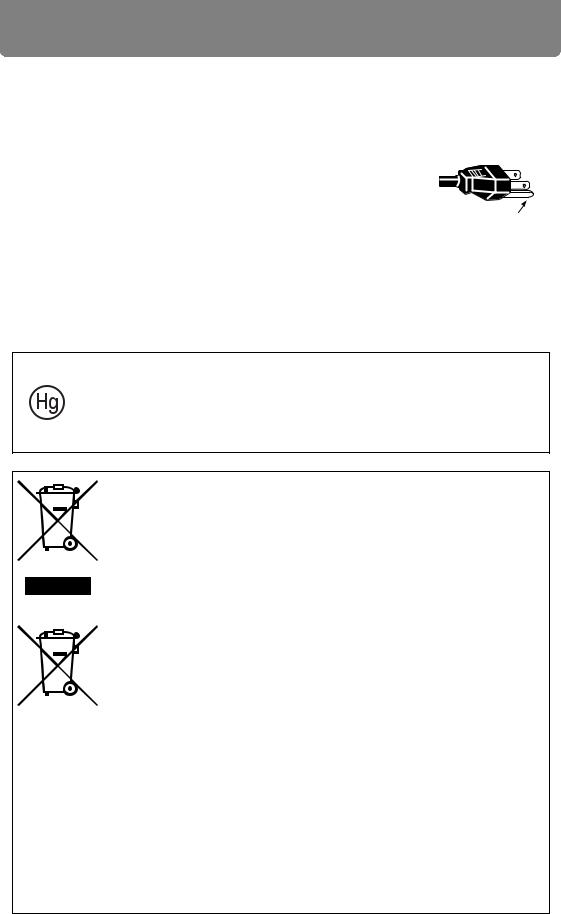
Safety Instructions
AC Power Cord Requirement
The AC Power Cord supplied with this projector meets the requirements for use in the country you purchased it.
AC Power Cord for the United States and Canada: |
|
|
|
|
|
The AC Power Cord used in the United States and Canada is |
|
|
listed by the Underwriters Laboratories (UL) and certified by |
|
|
the Canadian Standard Association (CSA). |
Ground |
|
The AC Power Cord has a grounding-type AC line plug. This is |
|
|
|
|
|
a safety feature to ensure the plug fits into the power outlet. Do |
|
|
not try to tamper with this safety feature. Should you be unable |
|
|
to insert the plug into the outlet, contact your electrician. |
|
|
|
|
|
THE SOCKET-OUTLET SHOULD BE INSTALLED NEAR THE EQUIPMENT AND EASILY ACCESSIBLE.
For the U.S. and Canada, LAMP (S) INSIDE THIS PRODUCT CONTAIN MERCURY AND MUST BE RECYCLED OR DISPOSED OF ACCORDING TO LOCAL, MUNICIPAL, STATE, PROVINCIAL, OR FEDERAL LAWS. For lamp recycling and disposal information please call 1-800-OK-CANON for the U.S. and Canada.
Only for European Union and EEA (Norway, Iceland and
Liechtenstein)
These symbols indicate that this product is not to be disposed of with your household waste, according to the WEEE Directive (2012/ 19/EU), the Battery Directive (2006/66/EC) and/or national legislation implementing those Directives.
If a chemical symbol is printed beneath the symbol shown above, in accordance with the Battery Directive, this indicates that a heavy metal (Hg = Mercury, Cd = Cadmium, Pb = Lead) is present in this battery or accumulator at a concentration above an applicable threshold specified in the Battery Directive.
This product should be handed over to a designated collection point, e.g., on an authorized one-for-one basis when you buy a new similar product or to an authorized collection site for recycling waste electrical and electronic equipment (EEE) and batteries and accumulators. Improper handling of this type of waste could have a possible impact on the environment and human health due to potentially hazardous substances that are generally associated with EEE. Your cooperation in the correct disposal of this product will contribute to the effective usage of natural resources.
For more information about the recycling of this product, please contact your local city office, waste authority, approved scheme or your household waste disposal service or visit www.canon-europe.com/weee, or www.canon-europe.com/battery.
14

Safety Instructions
Federal Communication Commission Notice
Multimedia Projector, Model: WUX6000
This device complies with Part 15 of the FCC Rules. Operation is subject to the following two conditions:
(1)This device may not cause harmful interference, and
(2)this device must accept any interference received, including interference that may cause undesired operation.
Note: This equipment has been tested and found to comply with the limits for a Class B digital device, pursuant to Part 15 of the FCC Rules. These limits are designed to provide reasonable protection against harmful interference in a residential installation. This equipment generates, uses and can radiate radio frequency energy and, if not installed and used in accordance with the instructions, may cause harmful interference to radio communications. However, there is no guarantee that interference will not occur in a particular installation. If this equipment does cause harmful interference to radio or television reception, which can be determined by turning the equipment off and on, the user is encouraged to try to correct the interference by one or more of the following measures:
•Reorient or relocate the receiving antenna.
•Increase the separation between the equipment and receiver.
•Connect the equipment into an outlet on a circuit different from that to which the receiver is connected.
•Consult the dealer or an experienced radio / TV technician for help.
The cable with a ferrite core provided with the projector must be used with this equipment in order to comply with Class B limits in Subpart B of Part 15 of the FCC rules.
Use of a shielded cable is required to comply with class B limits in Subpart B of Part 15 of FCC Rules.
Do not make any changes or modifications to the equipment unless otherwise specified in the instructions. If such changes or modifications should be made, you could be required to stop operation of the equipment.
Canon U.S.A. Inc.
One Canon Park, Melville, New York 11747, U.S.A. Tel No. (631) 330-5000
Instructions Safety
15
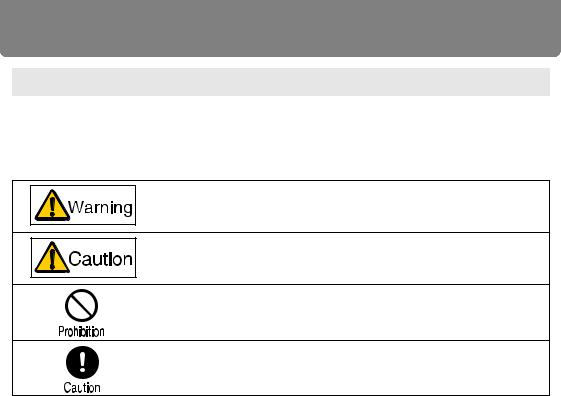
Safety Instructions
Safety Symbols in this Manual
This section describes the safety symbols used in this manual. Important projector safety information is identified by the following symbols. Always observe the safety information by these symbols.
Denotes the risk of death or serious injury from improper handling if the information is not observed. To ensure safe use, always observe this information.
Denotes the risk of injury from improper handling if the information is not observed. To ensure safe use, always observe this information.
Denotes prohibited actions.
Denotes required actions or information that must be observed.
16
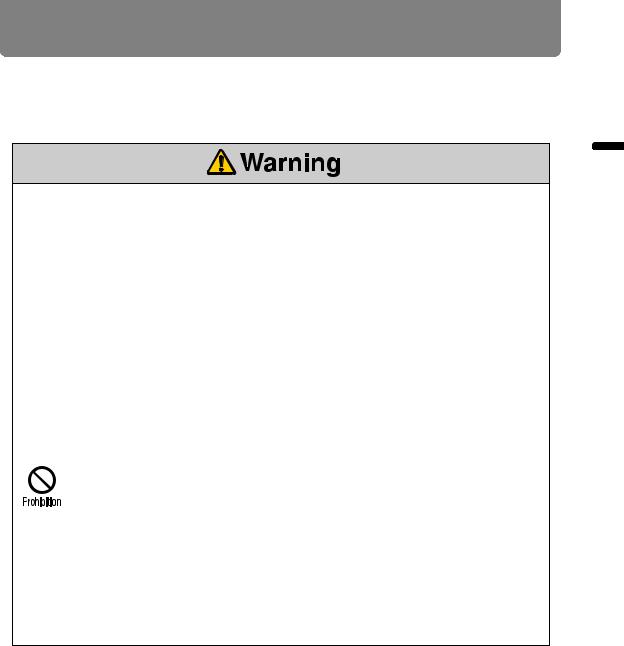
Safety Instructions
Precautions for Use
As this section contains important safety-related information, be sure to read the following carefully beforehand in order to use your projector correctly and safely.
During installation, keep the projector plug easily accessible so that the projector can be unplugged immediately if necessary, or keep a circuit breaker within reach.
If the following situations occur, turn the power off, remove the power plug from the power outlet and contact the Canon Customer Support Center. Failure to do so could cause a fire or result in an electric shock.
•If smoke is emitted
•If an unusual smell or noise is emitted
•If water or other liquid has entered the projector
•If metal or any other foreign material has entered the projector
•If the projector is knocked over or dropped and the cabinet is damaged
Pay attention to the following points for handling the power cord. Failure to do so may cause a fire, electric shock or personal injury.
•Do not place any objects on the power cord and do not allow it to become trapped under the projector.
•Do not cover the power cord with a carpet.
•Do not modify or excessively bend, twist, pull, wind, or bundle the power cord.
•Keep the power cord away from heaters and other sources of heat.
•Do not use a damaged power cord. If the power cord is damaged, purchase a replacement from your dealer.
•The power cord included with this projector is for use exclusively with this product. Do not use this cord for other products.
•Be sure to connect the ground wire of the power cord to ground.
•Be sure to connect the ground wire before connecting the power plug to the outlet. Also when you disconnect the ground wire, be sure to unplug the power plug from the outlet beforehand.
Instructions Safety
17

Safety Instructions
Pay attention to the following points regarding the power source, power plug and handling of the connector. Failure to do so may cause a fire, electric shock or personal injury.
•Do not use any power source with a voltage other than the voltage indicated (AC 100–240 V).
•Do not pull the power cord and be sure to hold the power plug or connector
when removing. Incorrect handling may damage the power cord.
• Do not insert any metal objects into the contact parts of the power plug or connector.
•Do not remove the power plug or connector with wet hands.
•Insert the power plug and connector securely up to the base. Additionally, do not use a damaged power plug or an outlet that is loose.
• When using an extension cord, do not exceed the cord’s rated capacity.
•Periodically inspect the power plug and outlet and remove any dust or dirt from between the plug and the outlet.
Installation and Handling Precautions
Pay attention to the following points regarding installation and handling of the projector. Failure to do so may cause a fire, electric shock or personal injury.
•Do not use the projector where it might get wet, such as outdoors or by bathtubs or showers.
•Do not place containers containing a liquid on top of the projector.
•Do not touch the projector itself, the power cord, or the cable if lightening strikes.
•Do not move the projector until you have switched off the power, removed the power plug from the power outlet and unplugged any other cables.
•Unplug the projector before cleaning or maintenance.
•Before installing or replacing a lens unit, make sure to remove the power plug from the outlet. Failure to do so could result in an electric shock or injury.
18
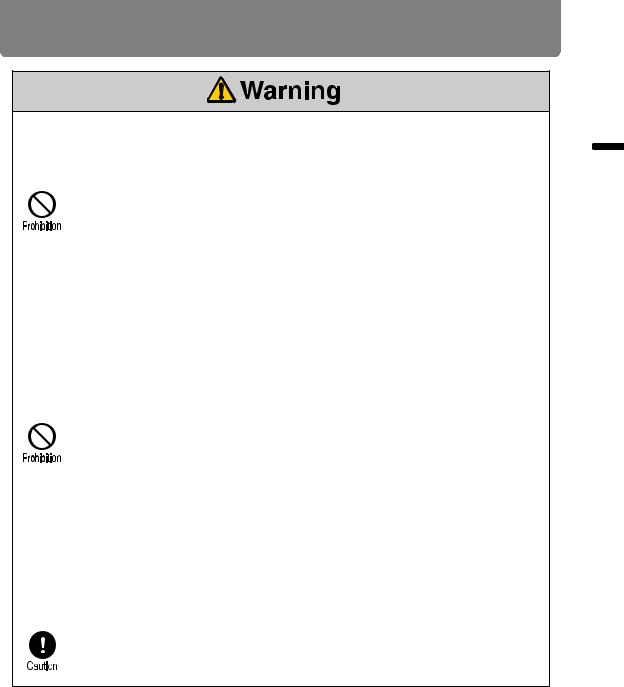
Safety Instructions
Pay attention to the following points regarding installation and handling of the projector. Failure to do so may cause a fire, electric shock or personal injury.
•Do not remove the cabinet from the projector or disassemble it. The interior of the projector contains high-voltage components as well as parts that are hot. If inspection, maintenance or repair is required, contact the Canon Customer Support Center.
• Do not disassemble or modify the projector (including consumable parts) or the remote control.
•Do not look directly into the exhaust vents during use.
•Do not insert any object into vents in the projector, such as the air intake vent or exhaust vents.
•Do not place a pressurized can in front of the exhaust vents. The pressure of the contents of the can may increase due to heat from the exhaust vents and this could result in an explosion.
•Using the lens shift function the lens in the projector moves up / down / left / right powered by a motor. Do not touch the lens when the lens is moving. Doing so could cause a personal injury.
•Before replacing the lens unit, wait at least one hour after the projector is turned off to allow the projector to cool thoroughly. Failure to do so could result in a burn or injury.
•When cleaning off dust or dirt from the projector lens etc., do not use any kind of spray that is flammable. As the temperature of the lamp inside the projector is high, it could ignite, causing a fire.
•As strong light beams are emitted while the projector is in use, do not look directly into the projector lens. Doing so could cause an eye injury. Pay particular attention to prevent small children from doing so.
•When setting the projector on a high surface for projection, be sure the surface is flat and stable.
•For ceiling mounting precautions, refer to the installation manual included with the ceiling mount (sold separately).
•When hanging the projector from a ceiling, put the projector down on the floor or a workbench before attaching or replacing the lens unit. Failure to do so could result in parts falling off the projector and may cause an accident or personal injury.
Instructions Safety
19
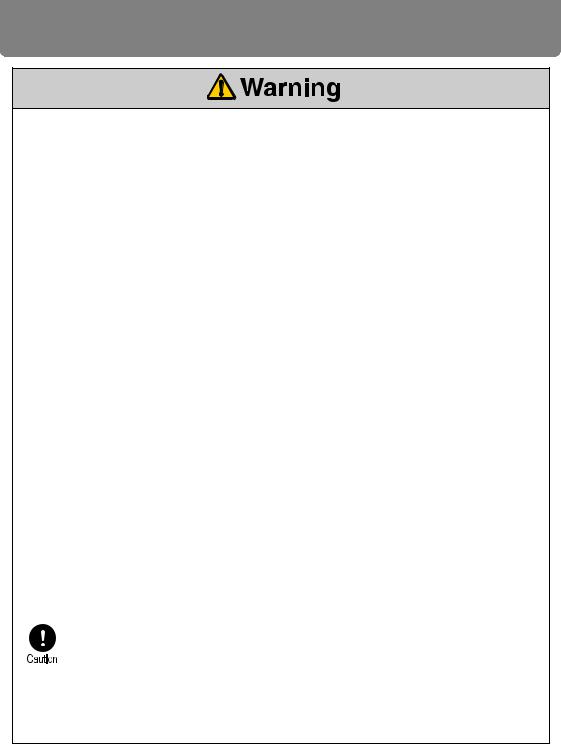
Safety Instructions
Precautions on the Lamp
This projector uses a high-pressure mercury lamp, which must be handled carefully and correctly as described below.
The mercury lamp has the following characteristics.
•The lamp will gradually become darker over time.
•Impact, abrasion, or use of worn-out lamps may cause lamps to rupture (accompanied by a loud noise) or burn out.
•Lamps are more likely to rupture after the lamp replacement message is displayed (see “Replacing the Lamp” (P197)). Replace the lamp with a new one as soon as possible.
•Useful life of lamps varies widely from lamp to lamp and depending on the environment of use. Some lamps may fail or rupture soon after they are first used.
•Be prepared by keeping a spare lamp.
Note the following precautions during lamp replacement or when a lamp has ruptured. Failure to do so could result in an electric shock or personal injury.
•Before replacing the lamp, always unplug the projector and wait at least an hour.
•Ruptured lamps may scatter shards of glass inside the projector. Contact the Canon Customer Support Center for cleaning and inspection of the projector interior and lamp replacement.
Precautions when replacing lamps that stop working
•If illumination suddenly stops, either when you turn the projector on or after it has been on for a while, the lamp may have ruptured. In this case, never attempt to replace the lamp by yourself. Always request service from the Canon Customer Support Center.
•With ceiling-mounted projectors, the lamp may fall out when you open the
lamp cover, or during replacement. During replacement, stand to the side of the lamp cover, not directly under it.
• If the lamp ruptures, dust and gas (containing mercury vapor) may come out of the exhaust vents. If this happens, immediately open the windows and doors to provide ventilation to the room.
•If you accidentally inhale gas from the lamp or get any pieces in your eyes or mouth, consult a doctor immediately.
20
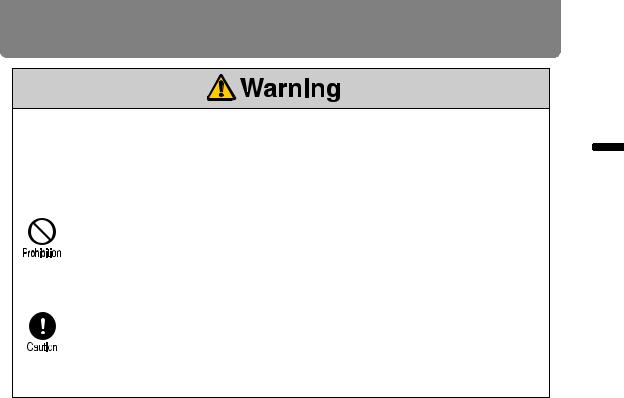
Safety Instructions
Precautions for the Batteries of the Remote Control
Pay attention to the following points regarding handling of batteries. Failing to do so could result in a fire or personal injury.
•Do not heat, short circuit or disassemble the batteries, or place them in a fire.
•Do not attempt to recharge the batteries that are included with the remote
control.
•Remove the batteries when they are flat or when the remote control will not be used for a long period of time.
•When replacing the batteries, replace both at the same time. Also, do not use two batteries of a different type at the same time.
•Insert the batteries with the + and - terminals in the correct directions.
•If any liquid from inside the batteries leaks out and contacts your skin, be sure to wash the liquid off thoroughly.
Instructions Safety
21
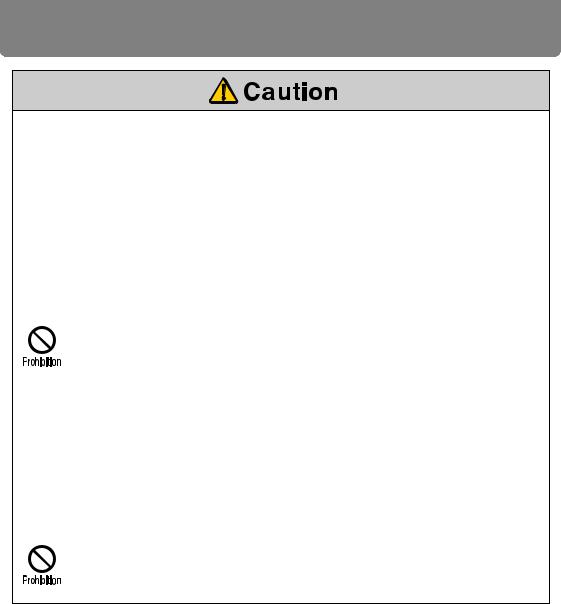
Safety Instructions
Pay attention to the following points regarding installation and handling of the projector.
•If the projector will not be used for a long period of time, be sure to remove the power plug from the power outlet to ensure safety. Failure to do so presents a risk of fire if dust accumulates on the plug or outlet.
•Parts of the cabinet around and above the exhaust vents may become hot during projection. Touching these areas during operation could cause burns to the hands. Pay particular attention in preventing young children from touching these parts. Additionally, do not place any metal objects around or above the exhaust vents. Due to the heat from the projector, doing so could cause an accident or personal injury.
•Do not place the projector where it may be exposed to oily smoke or steam, such as near kitchen counters or humidifiers. Doing so may cause fire or electric shock.
•Do not place any heavy objects on top of the projector or sit / stand on it. Pay
particular attention to prevent small children from doing so. The projector may be knocked over and this could result in damage or a personal injury.
•Do not place the projector on an unstable or slanted surface. Doing so may cause the projector to fall or be knocked over and could result in a personal injury.
•Do not place any objects in front of the lens during projection. Doing so could cause a fire.
•Presenters in front of the projector should stand where the light does not seem too bright, and where their shadow does not fall on the screen.
When handling the lamp, pay attention to the following points.
•Be sure not to handle the lamp immediately after it has been used. Be sure to switch off the power and wait for approximately 1 hour for the lamp and the projector to cool down sufficiently. Failure to do so could result in a burn
or personal injury due to heat from the lamp or projector.
22

For Safe Use
Pay attention to the following points when carrying or transporting the projector.
•This projector is a precision instrument. Do not knock it over or subject it to impacts. Doing so may cause a malfunction.
•When carrying or holding up the projector after attaching the lens unit, be sure not to hold the lens. Doing so may cause damage to the lens unit.
•Do not reuse any packaging or shock-absorbent materials that were supplied with the projector at the time of purchase for transporting or shipping the projector. Protection of the projector cannot be guaranteed if used packaging or shock-absorbent materials are reused. Fragments from shock-absorbent material may also enter the interior of the projector which could cause a malfunction.
•If transportation is necessary, the lens unit should be removed before
transporting the projector. If the projector is subjected to excessive impacts during transportation, the lens unit may be damaged. Removal and installation of the lens unit should not be performed by the user. Be sure to have the procedure performed by a qualified technician or contact the Canon Customer Support Center.
•Disconnect the cables connected to the projector. Carrying the projector while the cables are attached may cause an accident.
•Retract the adjustable feet before moving the projector. Leaving the feet extended may cause damage.
Use Safe For
23
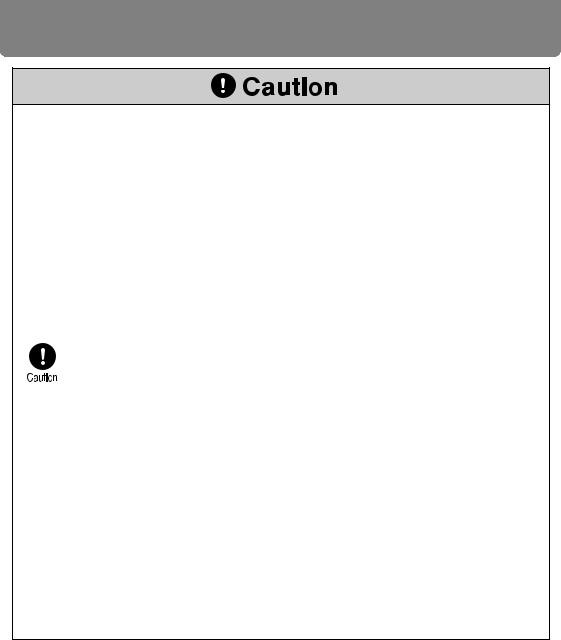
For Safe Use
Pay attention to the following points when installing or using the projector.
•Do not touch the lens with bare hands. Doing so may result in deterioration of image quality.
•If the projector is abruptly taken from a cool to a warm location, condensation may form on the lens or mirrors, which may cause a blurred image. Wait until the condensation has evaporated for the image projected to return to normal.
•Do not install the projector in a location where the temperature is high or low. Doing so may cause a malfunction. For guidelines on operating temperatures, see “Product Specifications”.
•Do not place any objects on top of the projector that may change shape or color due to heat.
•Projector settings must be adjusted when using the projector at high altitudes or in upward or downward projection. Failure to adjust the settings may shorten the lamp life or damage the lamp. For details, contact the Canon Customer Support Center.
•Do not install the projector near high-voltage electrical power lines or an electrical power source.
•Do not use the projector on a soft surface such as carpet or sponge mat, etc. Doing so could cause heat to build up inside the projector and this could result in a malfunction.
•Do not block the air intake or exhaust vents of the cooling fan. If the air intake or exhaust vent is blocked, heat cannot be released from inside the projector, which may shorten the useful life of the lamp or cause malfunction.
•Installing the projector in the wrong direction may cause a malfunction or accident. Do not install the projector with one side raised, or with the projector tilted toward the left or right.
•Install the projector with sufficient space between air intakes and exhaust vents and walls. Failure to do so could cause a malfunction.
•Do not install the projector in a location that is damp, or where there is a lot of dust, oily smoke or tobacco smoke. Doing so could cause contamination of optical components such as the lens and the mirror and may result in deterioration of image quality.
24

Open Source Software
The product contains Open Source Software modules. For details, see “ThirdPartySoftware.pdf” (Third-Party Software License) in the OpenSourceSoftware folder in the LICENSE folder on the Setup CD-ROM. Each module’s license conditions are also available in the same folder.
■ Software under the GNU General Public License Version 2
Contained programs are free software; you can redistribute them and/or modify them under the terms of the GNU General Public License attached to each copy of the program.
Each program is distributed in the hope that it will be useful, but WITHOUT ANY WARRANTY; without even the implied warranty of MERCHANTABILITY or FITNESS FOR A PARTICULAR PURPOSE. Please see “NO WARRANTY” and “NO SUPPORT” stated below. For more detail, please see full text of the GNU General Public License.
NO WARRANTY
BECAUSE THE PROGRAM IS LICENSED FREE OF CHARGE, THERE IS NO WARRANTY FOR THE PROGRAM, TO THE EXTENT PERMITTED BY APPLICABLE LAW. EXCEPT WHEN OTHERWISE STATED IN WRITING THE COPYRIGHT HOLDERS AND/OR OTHER PARTIES PROVIDE THE PROGRAM “AS IS” WITHOUT WARRANTY OF ANY KIND, EITHER EXPRESSED OR IMPLIED, INCLUDING, BUT NOT LIMITED TO, THE IMPLIED WARRANTIES OF MERCHANTABILITY AND FITNESS FOR A PARTICULAR PURPOSE. THE ENTIRE RISK AS TO THE QUALITY AND PERFORMANCE OF THE PROGRAM IS WITH YOU. SHOULD THE PROGRAM PROVE DEFECTIVE, YOU ASSUME THE COST OF ALL NECESSARY SERVICING, REPAIR OR CORRECTION.
IN NO EVENT UNLESS REQUIRED BY APPLICABLE LAW OR AGREED TO IN WRITING WILL ANY COPYRIGHT HOLDER, OR ANY OTHER PARTY WHO MAY MODIFY AND/OR REDISTRIBUTE THE PROGRAM AS PERMITTED ABOVE, BE LIABLE TO YOU FOR DAMAGES, INCLUDING ANY GENERAL, SPECIAL, INCIDENTAL OR CONSEQUENTIAL DAMAGES ARISING OUT OF THE USE OR INABILITY TO USE THE PROGRAM (INCLUDING BUT NOT LIMITED TO LOSS OF DATA OR DATA BEING RENDERED INACCURATE OR LOSSES SUSTAINED BY YOU OR THIRD PARTIES OR A FAILURE OF THE PROGRAM TO OPERATE WITH ANY OTHER PROGRAMS), EVEN IF SUCH HOLDER OR OTHER PARTY HAS BEEN ADVISED OF THE POSSIBILITY OF SUCH DAMAGES.
NO SUPPORT
Canon Inc., and all its subsidiaries or its dealers do not make any support service regarding the source code. Canon Inc., and all its subsidiaries or its dealers shall not respond to any questions or enquiries, from you or any other customers, regarding the source code.
Software Source Open
25
26

Before Use
Table of Contents
Safety Instructions
Before Use
Operation |
Projecting an Image |
|
Useful Functions Available |
||
|
||
|
During a Presentation |
|
|
Setting Functions from |
|
|
Menus |
|
|
Connecting to a Network |
|
andInstallation |
||
|
Installation |
|
Maintenance |
Maintenance |
|
|
||
|
Other Information |
|
|
||
Appendix |
||
Index |
||
|
||
|
|
27
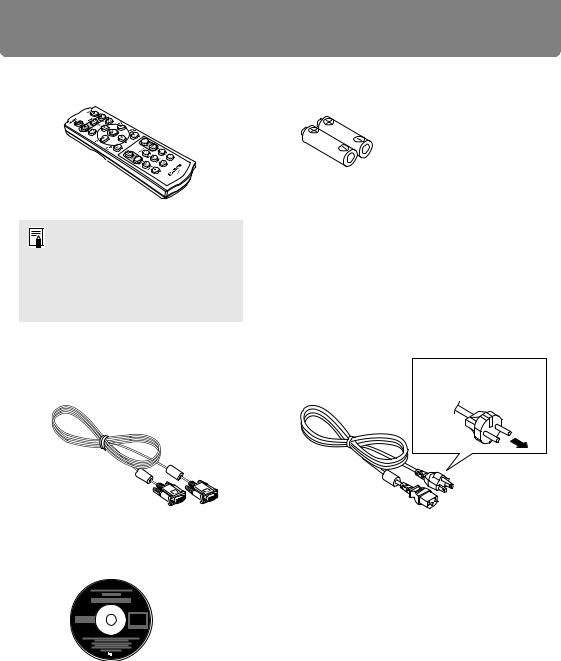
Supplied Accessories
Check that the following accessories have been supplied with the projector.
• Remote control |
• Batteries for the remote control |
(AAA size x2)
(part No.: RS-RC04)
Optional remote controls are also available (RS-RC05). However, some buttons are not supported with this projector. The RS-RC05 can also be used as a wired remote. (P30)
•Computer cable (1.8 m / 5.9')
(mini D-sub 15-pin / mini D-sub 15-pin)
•CD-ROM
User’s Manual / Supplement NMPJ Ver. 1.1 User’s Manual
• Power cord (1.8 m / 5.9')
For Continental
Europe
For the U.S.A. and
Canada
•Warranty Card
•Important Information
28
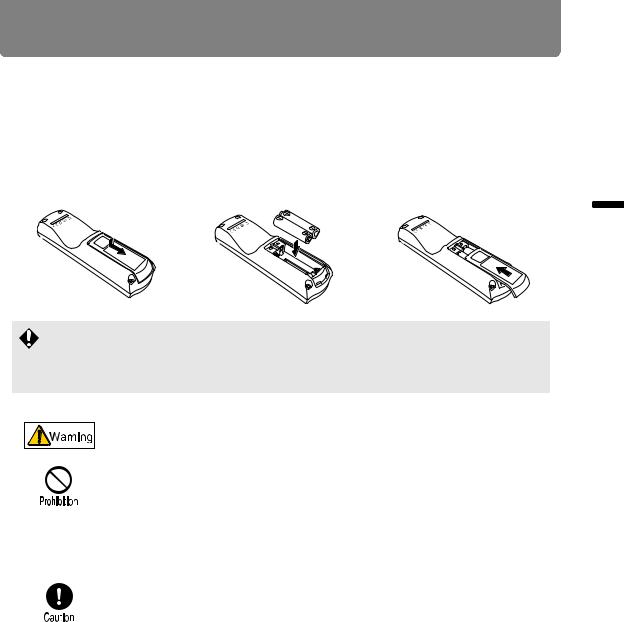
Preparing the Remote Control
■ Installing Remote Control Batteries
1 Open the battery |
2 Insert batteries. |
3 Close the |
compartment lid. |
Insert 2 new AAA |
compartment lid. |
Slide the lid while |
batteries in the |
Slide the lid until you |
pressing it down. |
compartment with the |
hear a click to |
|
+ and – poles |
securely close it. |
|
positioned correctly. |
|
Use Before
•If buttons on the remote control are inoperative when you attempt to operate the projector, replace the batteries with new ones.
•Do not drop the remote control or subject it to impact.
•Do not spill any liquids on the remote control. Doing so could damage it.
Pay attention to the following points when handling the batteries.
Failing to do so could result in a fire or personal injury.
•Do not heat, short circuit or disassemble the batteries, or place them in a fire.
•Do not attempt to recharge the batteries that are included with the remote control.
•Remove the batteries when they are flat or when the remote control will not be used for a long period of time.
•When replacing the batteries, replace both at the same time. Also, do not use two batteries of a different type at the same time.
•Insert the batteries with the + and - terminals in the correct directions.
•If any liquid from inside the batteries leaks out and contacts your skin, be sure to wash the liquid off thoroughly.
29
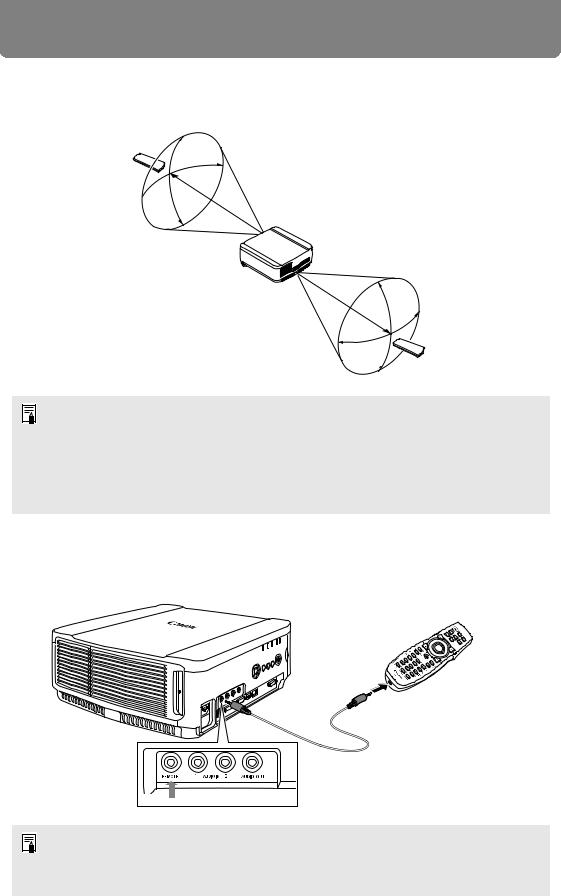
Preparing the Remote Control
■ Remote Control Operating Range
The remote control is an infrared type. Point it at the infrared remote receiver on the front or rear of the projector to operate it.
25°
 8 m (26.3') 25°
8 m (26.3') 25°
 8 m (26.3')
8 m (26.3')
25°
25°
• Use the remote control within an angle of 25° in any direction from directly in front of the infrared remote receiver.
•The remote control may be inoperative if there is an obstacle between the remote control and the projector or the infrared remote receiver on the projector is exposed to direct sunlight or strong light of lighting equipment.
•When you use 2 or more projectors at the same time, you can change the channel settings to prevent the 2 remote controls from interfering with each other. (P102)
■Using an Optional Wired Remote (RS-RC05)
To use a wired remote control with the projector, use the RS-RC05, sold separately. Use a cable with a ø3.5 mm stereo mini jack (not included).
Terminal for wired remote control
ø3.5 mm stereo mini jack cable (not included)
• Infrared operations cannot be performed if a cable is connected to the projector or the remote control.
•Use a cable with a ø3.5 mm stereo mini jack (not included) with a length of 30 m (98.4') or less.
30
